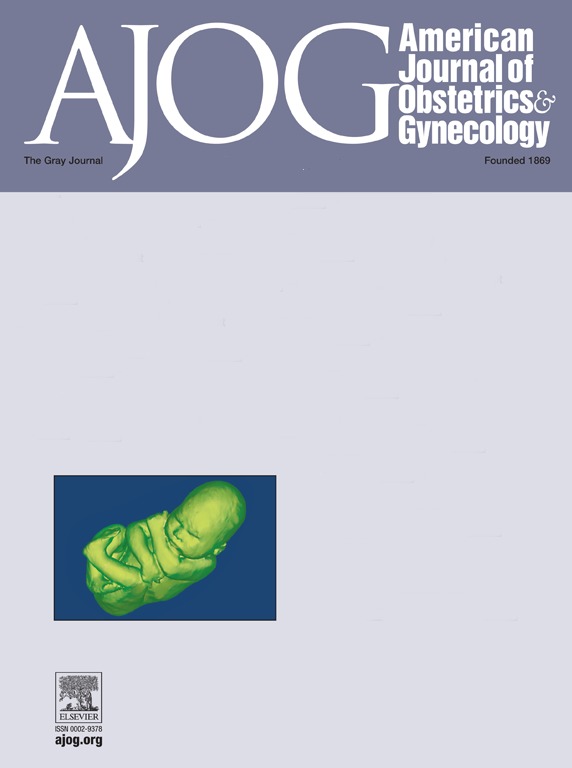早期宫颈癌淋巴结分期后的长期淋巴水肿和生活质量:前瞻性多中心SENTIREC宫颈研究的3年随访
IF 8.4
1区 医学
Q1 OBSTETRICS & GYNECOLOGY
引用次数: 0
摘要
盆腔淋巴结切除术(PL)是宫颈癌淋巴结分期的金标准,但会增加腿部淋巴水肿(LL)的风险。前哨淋巴结(SLN)定位是一种侵入性较小的技术,能够准确检测淋巴结转移,尽管尚未有证据证实其肿瘤学安全性。了解慢性LL和PL或SLN定位后的生活质量(QOL)对于确定宫颈癌妇女的治疗和生存策略至关重要,但目前的证据有限。目的:评估宫颈癌妇女单独SLN定位和SLN定位+ PL后的长期LL。进一步,在12个月的随访中检查LL的危险因素和LL患者的病情特异性生活质量。这项全国前瞻性队列研究纳入了接受根治性手术的早期宫颈癌患者,包括SLN定位(2017-2021)。当肿瘤直径大于20 mm时,行后备PL。患者在手术前和术后3、12、24和36个月完成有效的患者报告结果问卷。LL由欧洲癌症研究和治疗组织(EORTC)宫颈癌模块(QLQ-CX24)评估,并由EORTC项目库中的8个单个项目补充,这些项目涉及腿部、生殖器和腹沟的淋巴水肿。根据淋巴水肿生活质量(lyqol)工具、EORTC QLQ-C30和QLQ-CX24模块报告生活质量。从基线到每次随访的平均差异评分以95%置信区间(ci)估计,将8分或更多的变化定义为临床显著性。采用线性回归模型检验术后12个月的预测因素。我们评估了淋巴水肿患者的lyqol域内的生活质量,并使用多元线性回归分析了域的趋势。我们使用解释临床重要差异的指南来比较有LL和没有LL患者的生活质量。结果在109名单独进行SLN定位的女性中,从基线到3、12和36个月的LL平均评分差异分别为6 (95% CI: 2-10)、10 (95% CI: 5-15)和15 (95% CI: 7-22)。在相似的时间点,77名女性在SLN定位+ PL后报告了严重的LL,平均评分差异为18 (95% CI: 11-25), 29 (95% CI: 21-37)和21 (95% CI: 11-32)。无论淋巴结切除程度如何,3个月的LL评分与12个月的LL评分呈正相关。BMI预测单独SLN制图后的LL,而放化疗与备份PL后的淋巴水肿相关。12个月随访时报告的淋巴水肿与几个生活质量方面的损害相关,包括疲劳、疼痛、身体、认知、社交和性功能。结论宫颈癌患者长期LL以SLN作图+ PL为主,单纯SLN作图者较少。三个月LL评分预测持续淋巴水肿,这与一些生活质量症状和功能的恶化显著相关。我们的研究结果为该领域提供了新的知识,支持了微创手术方法,并可能使共同决策和生存干预成为可能。本文章由计算机程序翻译,如有差异,请以英文原文为准。
Long-term lymphedema and quality of life following lymph node staging in early cervical cancer: 3 years follow-up in the prospective multicenter SENTIREC CERVIX study.
BACKGROUND
Pelvic lymphadenectomy (PL) is the gold standard in nodal staging in cervical cancer but increases risk of leg lymphedema (LL). Sentinel lymph node (SLN) mapping is a less invasive technique enabling accurate detection of nodal metastases, although evidence confirming its oncological safety has yet to be established. Knowledge on chronic LL and quality of life (QOL) following PL or SLN mapping is essential for qualifying treatment and survivorship strategies in women with cervical cancer but current evidence is limited OBJECTIVES: To evaluate long-term LL after SLN mapping alone and SLN mapping + PL in women with cervical cancer. Further, to examine risk factors for LL and the condition-specific QOL among patients with LL at 12 months follow-up.
STUDY DESIGN
This national prospective cohort study included patients with early-stage cervical cancer who underwent radical surgery including SLN mapping (2017-2021). In case of tumors >20 mm, back-up PL was performed. Patients completed validated patient-reported outcome questionnaires before surgery and 3, 12, 24, and 36 months postoperatively. LL was assessed by the European Organization of Research and Treatment of Cancer (EORTC) cervix cancer module (QLQ-CX24), supplemented by eight single items from the EORTC item library addressing lymphedema of the legs, genitals, and groins. QOL was reported according to the Lymphedema Quality of Life (LYMQOL) tool, the EORTC QLQ-C30 and the QLQ-CX24 modules. Mean difference scores from baseline to each follow-up were estimated with 95% confidence intervals (CIs), defining a change of 8 points or more as clinically significant. Linear regression models were used to examine predictors of LL 12 months postoperatively. We evaluated QOL within LYMQOL domains in patients with lymphedema and analyzed domain trends using multiple linear regression. We compared QOL in patients with and without LL using guidelines for interpretation of clinically important differences.
RESULTS
Among 109 women who underwent SLN mapping alone, LL mean score differences from baseline to 3, 12, and 36 months were 6 (95% CI: 2-10), 10 (95% CI: 5-15), and 15 (95% CI: 7-22), respectively. At similar time points, 77 women reported substantial LL after SLN mapping + PL, with mean score differences of 18 (95% CI: 11-25), 29 (95% CI: 21-37), and 21 (95% CI: 11-32). Three-month LL scores were positively associated with LL scores at 12-months regardless of the extent of lymph node removal. BMI predicted LL after SLN mapping alone, whereas chemoradiotherapy was associated with lymphedema following back-up PL. Reporting lymphedema at 12-month follow-up was associated with impairment in several QOL aspects including fatigue, pain, physical, cognitive, social and sexual functioning.
CONCLUSION
Patients with cervical cancer reported long-term LL, most pronounced after SLN mapping + PL, and to a lesser extent after SLN mapping alone. Three months LL score predicted persistent lymphedema which was significantly associated with deterioration in several QOL symptoms and functioning. Our findings contribute with new knowledge in the field and support less invasive surgical approaches and may qualify shared decision making and survivorship intervention.
求助全文
通过发布文献求助,成功后即可免费获取论文全文。
去求助
来源期刊
CiteScore
15.90
自引率
7.10%
发文量
2237
审稿时长
47 days
期刊介绍:
The American Journal of Obstetrics and Gynecology, known as "The Gray Journal," covers the entire spectrum of Obstetrics and Gynecology. It aims to publish original research (clinical and translational), reviews, opinions, video clips, podcasts, and interviews that contribute to understanding health and disease and have the potential to impact the practice of women's healthcare.
Focus Areas:
Diagnosis, Treatment, Prediction, and Prevention: The journal focuses on research related to the diagnosis, treatment, prediction, and prevention of obstetrical and gynecological disorders.
Biology of Reproduction: AJOG publishes work on the biology of reproduction, including studies on reproductive physiology and mechanisms of obstetrical and gynecological diseases.
Content Types:
Original Research: Clinical and translational research articles.
Reviews: Comprehensive reviews providing insights into various aspects of obstetrics and gynecology.
Opinions: Perspectives and opinions on important topics in the field.
Multimedia Content: Video clips, podcasts, and interviews.
Peer Review Process:
All submissions undergo a rigorous peer review process to ensure quality and relevance to the field of obstetrics and gynecology.

 求助内容:
求助内容: 应助结果提醒方式:
应助结果提醒方式:


